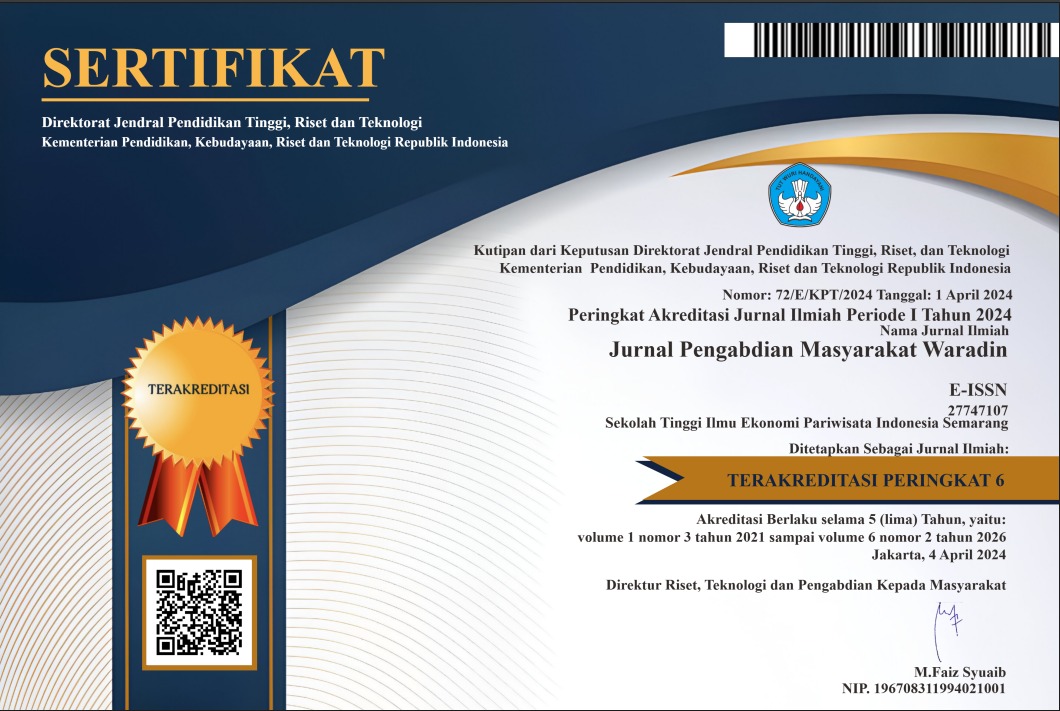Analisis Kualitas Air untuk Pengelolaan Sumber Daya Air Berkelanjutan dengan Pengujian Air Klorin
DOI:
https://doi.org/10.56910/wrd.v5i1.476Keywords:
Water, Quality, SustainableAbstract
Sustainable water resource management in Indonesian villages is essential to address poor water quality and low public awareness. This program aims to enhance the knowledge and skills of the community regarding sustainable water resource management. The methods used include training and water quality testing across 14 parameters, such as lead, copper, iron, chromium, pH, and free chlorine, in accordance with the standards set by the Ministry of Health Regulation. Results showed a 40% increase in community understanding after training, with all tested water parameters found to be within safe limits. The program successfully engaged the community in water quality monitoring, raising awareness and encouraging participation in sustainable water resource management. Although some participants initially faced difficulties in using the testing tools, intensive guidance was provided to overcome these challenges. In conclusion, the program positively contributed to improving the community's knowledge, skills, and participation in maintaining better water quality in the village.
References
Alaa, H., Ali., Noor, Al-Huda, Ahmad, Mohamed, Taher., Haifaa, Ahmad. (2024). 1. Water Resources, Crises, and Sustainability. Advances in environmental engineering and green technologies book series, doi: 10.4018/979-8-3693-4240-4.ch004
Ana, Zubiarrain-Laserna., Shayan, Angizi., Md., Ali, Akbar., Ranjith, Divigalpitiya., Ponnambalam, Ravi, Selvaganapathy., Peter, Kruse. (2022). 6. Detection of free chlorine in water using graphene-like carbon based chemiresistive sensors. RSC Advances, doi: 10.1039/d1ra08264g
Chay, Asdak., Yulizar., Subiyanto. (2023). A national policy on indonesia’s integrated water resource conservation management. Indonesian Journal of Forestry Research, doi:10.59465/ijfr.2023.10.2.151-162
Ciptadi, G., Anggayasti, W. L., Susanto, S., Rachmawati, C., Makikui, J. J., & Ubit, R. I. (2023). Manajemen Lingkungan dan Keberlanjutan Pembangunan. Universitas Brawijaya Press.
Elmi, Hidayana., Edy, Setiawan., Anda, Iviana, Juniani. (2024). 4. Classification of water quality based on dissolved solids and turbidity parameters with the utilization of total dissolved solids sensor and turbidity sensor. Journal of Soft Computing Exploration, doi: 10.52465/joscex.v5i3.376
Hanan, Hosni, Badr., Ali, Abdel, Rahman, Gad., Ahmed, M., Farghaly. (2022). 7. Assessment of water quality in chlorinated drinking water distribution networks regarding to trihalomethanes formation. JES. Journal of engineering sciences, doi: 10.21608/jesaun.2022.124056.1121
Irawan, M. I., Fahim, K., Jaelani, L. M., Hakim, O. S., & Susanto, S. (2023). Optimalisasi Estimasi Curah Hujan Berdasarkan Citra Radar Menggunakan Model Pembelajaran Mesin MLP. Jurnal Sains & Teknologi Modifikasi Cuaca, 24(2), 67-75.
Muhammad, Merei. (2024). 3. Empowering communities for sustainable water management: Insights from Justdiggit and the Paani Foundation. E3S web of conferences, doi: 10.1051/e3sconf/202455001042
Neha, Verma. (2024). 2. Help us Deal with Water Crisis! Solving Water Crisis to Save Lives.. International journal of innovative science and research technology, doi: 10.38124/ijisrt/ijisrt24may276
Owoseni, M., & Okoh, A. I. (2022). New insights into chlorine disinfectant usage in water quality: A need for review of existing guidelines. In O. Popoola, G. Nwoba, & O. Ogbonna (Eds.), Bioenergy and Environmental Biotechnology for Sustainable Development (pp. 159–176). Routledge
P.N., Patil., D.V., Sawant., R.N., Deshmukh. (2012). 2. Physico-chemical parameters for testing of water – A review. International Journal on Environmental Sciences,
Padder, F. A., & Bashir, A. (2023). Scarcity of water in the twenty-first century: Problems and potential remedies. Medalion, 4(1). https://doi.org/10.59733/medalion.v4i1.66
SS, Sagar., RP, Chavan., CL, Patil., DN, Shinde., SS, Kekane. (2015). 1. Physico-chemical parameters for testing of water- A review. International Journal of Chemical Studies,
Susanto, S. (2023). Analisis Kajian Bibliometrika Dalam Pemetaan Arcgis Curah Hujan Di Kabupaten Kediri. JURNAL ENGINEERING, 14(1), 67-76.
Susanto, S., Komari, A., Hendy, H., Triparianto, A. Y., & Efendi, A. F. (2023). Implementasi Program GHIPPA dalam Meningkatkan Kebutuhan Irigasi Air. Jurnal Pengabdian Masyarakat Nusantara, 5(3), 153-164.
Susanto, S., Pratikto, H., Winarto, S., & Siswanto, E. (2024). Pemetaan Curah Hujan dengan Metode Interpolasi Invers Distance Weighting (IDW) Kabupaten Kediri. JURNAL ENGINEERING, 15(1), 44-55.
Tjendani, H. T., Trimurtiningrum, R., Komariah, N. E., & Susanto, S. (2022). Konsep Smart Water Management System Pada Badan Penyelenggara Penyediaan Air Minum Dengan Kontrak Berbasis Kinerja. JURNAL INTAKINDO JATIM, 1(1), 82-90.
Tonni, Agustiono, Kurniawan., Erick, R., Bandala., Mohd, Hafiz, Dzarfan, Othman., Huihwang, Goh., Abdelkader, Anouzla., Kit, Wayne, Chew., Faissal, Aziz., Hussein, Al-Hazmi., Aulia, Nisa'ul, Khoir. (2024). 4. Implications of climate change on water quality and sanitation in climate hotspot locations: a case study in Indonesia. Water supply, doi: 10.2166/ws.2024.008







